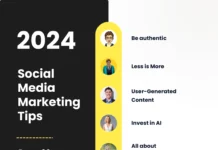
It’s February. You’re cold. And the tourism industry knows this. You’d think that this gives the digital marketers of tourism a head start, seeing as everyone wants to go on vacation all the time. But actually, to convert numerous people and direct them to certain locations takes constant innovation and novel digital marketing techniques.
Every one of these techniques can apply to a wide range of businesses, especially when it comes to utilizing new technologies, narratives, collaborations, and optimizing strategies for different form factors. The tourism industry is one of the most competitive after all, and with everyone feeling a little chilly on these brisk February evenings, a lot has to be done to gain an advantage.
With this in mind, we’re going to be exploring the five digital marketing takeaways from the tourism industry, providing some valuable perspectives on how they can be modified and applied throughout the business world.
5 Digital Marketing Lessons to Learn from the Tourism Industry
The Importance of SEO
Search engine optimization is a crucial component of digital marketing in any industry, but for the tourism sector, it’s fair to say the practice has truly been optimized. Whether you’re searching for food tourism recommendations or options for accommodation, you’ll come across plenty of carefully selected lists, blog posts, and reviews that have been keyword-optimized.
As of last year, however, it was revealed that 69% of companies are actively investing their time in an SEO campaign, while 80% are using blogs to engage their audience. This would suggest that around 20% of businesses are not conducting an SEO campaign in their onsite content. A strong SEO campaign isn’t about shoving as many links as possible into an offsite domain but optimizing engaging onsite content that is search engine friendly.
Embracing a Storytelling Approach
Speaking of engaging content, another area in which tourism shines is narrative. To truly connect with people, tourism companies have to be good at telling informative yet emotional stories that promote different destinations.
For instance, you could write a fairly substandard article on Ericeira Beach in Portugal, describing everything from a factual standpoint – essentially lifted from its Wikipedia page. But to grab the attention of consumers, it’s crucial to tell them how it feels, in the same way as this blog on Ericeira as a youth-focused destination – what’s it like to walk in the sand or watch a glistening sunset that blankets the ocean in a deep red?
This kind of content can capture the reader emotionally, and any emotional reaction is an engaged reaction. It’s not just condensed to blog posts, either. Tourism marketing constantly encourages emotional engagement even through travel ads, and this is an important thing to remember for businesses in any industry. Even a short advert should stress a product’s benefits and relate it to the target market’s wants and emotional goals. Here are some examples of the best travel ads in recent years:
- The Original GREAT Campaign for Britain:
- Airbnb’s Political Statement
- Inspired by Iceland
Social Media Engagement and Influencer Collaboration
Another method in which an emotional reaction can be achieved is through social media – specifically, utilizing influencers to excite an existing audience. Some of the most popular Instagram accounts are travel-related – or at least, have collaborated with travel firms in a selection of their posts – and this has done wonders to increase reach and improve the interactions that these brands have with their target audience.
Even beyond collaboration, these collaborations show the potential of true endorsement in the digital age. With their loyal followers and apparent genuineness, influencers can build trust and relatability that traditional advertising struggles to accomplish. Companies may produce effective marketing messages by choosing influencers whose values and audience match theirs.
This method is about emotional storytelling through trustworthy voices, not just reaching more people. Influencers offer products and experiences as personal recommendations rather than corporate messages, creating a more organic relationship with potential buyers. To give you an idea, here are a few examples:
- Jack Morris – 2.5 Million Followers

- Lauren Bullen – 2.1 Million Followers

- Brooke Saward – 524,000 Followers

Personalization and Customisation
As well as this, customized travel packages and recommendations are a specialty of the travel and tourism industry. In a recent survey, it was found that 66% of consumers expected companies to understand their unique needs, and 57% are willing to share their personal data in order to gain a more personalized experience. In the travel industry, the integration of tech like AI, machine learning, and big data analytics has been crucial in gathering deeper insights, predictions, and subsequently tailor-making consumer recommendations.

Of course, data privacy is a must in 2024, so the choice must be made by the consumer, but as mentioned before, consumers are ordinarily willing to share specific information if it leads to them being individualised. This will also help to build stronger, longer-lasting relationships with clients. As they grow to value their individualised experience – that appears to be catered directly to their wants and interests – they will experience enhanced satisfaction and loyalty. In other words, they won’t want to start again on the first page with another company.
Sustainable and Responsible Marketing
As sustainability has become a top priority for consumers, the tourism sector has been reflecting this by pushing environmentally friendly and ethical travel options. These values present many of them as socially conscious, in addition to meeting the consumer desire for sustainable options. This shouldn’t only be true for the tourism industry, however. Companies around the world can take a cue from this and apply sustainable messages and practices to their marketing plans, working to stand out in a crowded market and establish a brand that shares the ethical values of its customers.
This goes beyond projecting an eco-friendly image to reduce damage and benefit communities. For the company itself, it can boost product innovation, operational efficiency, and community relations. Sustainability in marketing tactics appeals to consumers’ consciences while supporting responsible company practices that help the world.
Conclusion
So there we have it! Firms in any industry can learn a lot from the tourism sector’s approach to digital marketing. Through the adoption of storytelling, utilization of personalized content, SEO optimization, and sustainable innovation, businesses may improve their digital marketing tactics and establish stronger connections with their target audiences. The tourist sector is a leader in digital marketing strategies in this way, and if a business – no matter their specific industry – takes a few of their cues, their marketing strategy is likely to kick up a few notches.
See also: Can you make money with a travel Instagram account?











